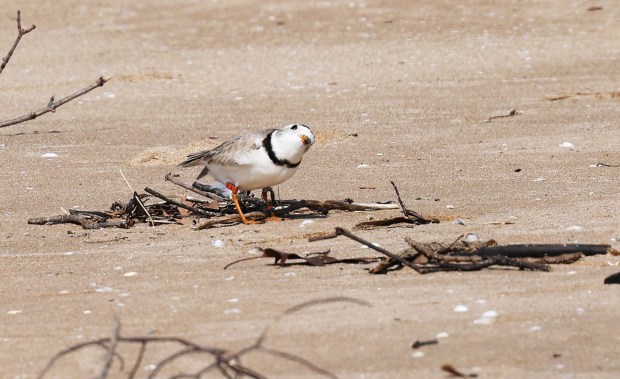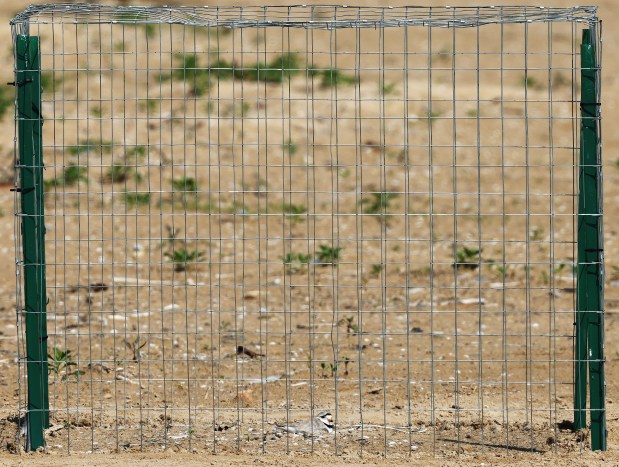Captive-reared piping plovers are making history as they guard two separate nests with eggs in Waukegan and Chicago.
Three plover eggs were documented Saturday in Waukegan, and 30 miles down the Lake Michigan shoreline, another egg was confirmed at Montrose Beach.
“This is an historic event for the Great Lakes Piping Plover Project,” said Brad Semel, endangered species recovery specialist for the Illinois Department of Natural Resources.
Three of the four parents-to-be, Blaze, Pepper and Searocket, hatched in a captive-rearing facility in Michigan last summer. They were released as chicks near Montrose Beach and Illinois Beach State Park in Zion last July, and have returned from their southerly wintering locations to start families.
The fourth plover is Imani, born in the wild at Montrose Beach to Monty and Rose, the famous plover pair that first captured Chicago’s attention in 2019.
Captive-reared plovers have never laid eggs in Illinois before, only in Michigan, Semel said.
If all goes well, in another month, the new parents will be doting on up to four hatchlings at each nest, he said.
The three captive-reared plovers began as eggs laid on a New York beach in the spring of 2023. When a hawk killed one of their incubating parents, the eggs were whisked away to a Michigan facility where they would have a better chance to survive. About a month after they hatched, Semel picked them up and drove them in a cat carrier to Illinois to release them.
“It’s been a very long time since piping plovers were nesting in two different locations along the lakeshore in Illinois,” Semel said.
Volunteer monitors at both locations are overjoyed and cautious as they work to educate people about the need to protect the rare birds and the shoreline ecosystem in which they live.
Piping plovers in Chicago: How the ‘love story’ between Monty and Rose unfolded at Montrose Beach
Carolyn Lueck, a volunteer plover monitor with the Lake County Audubon Society’s Sharing Our Shore-Waukegan program has been visiting Blaze and Pepper almost daily since the plovers returned from two different wintering homes within a day of each other in May.
“By Saturday, we had three eggs and were anticipating a fourth,” said Lueck, a former Lake Forest and Chicago resident who now lives in Pleasant Prairie, Wisconsin. If the captive-reared plovers can raise wild piping plovers, that will show the “great experiment,” to save the endangered shorebird species can be successful, she said.
“Blaze and Pepper have been very diligent,” Lueck said. “They never leave that nest unattended. They’re protecting it from the grackles and other threats.”
However, volunteer monitors acting as plover protectors had to intervene recently when a grackle, a type of blackbird that eats crops and garbage and also raids bird nests, got inside the cage.
“On Saturday, Pepper was on the nest, and he got up a few times to get a couple of bugs,” Lueck said. “Blaze was out foraging for a very long time. She has to have been using lots of energy to lay her eggs.”
Piping plovers typically lay one egg every other day, for a total of four. After that, they incubate the eggs and the young hatch simultaneously about a month later.
On Montrose Beach, Tamima Itani, lead volunteer and interagency coordinator for the Chicago Piping Plovers monitors, said she marvels that Searocket, at only 11 months old, was able to return to where she was released, mate and lay an egg.
“I also celebrate the fact that Imani’s need for a mate is now fulfilled after two seasons without one,” Itani said.
Imani’s parents, Monty and Rose, attempted to nest in Waukegan in 2018 and then successfully raised young at Montrose Beach in 2019, 2020 and 2021.
Monty died in 2022 waiting at Montrose for Rose to return.
She never did, but their son Imani has returned to his birthplace the past three years hoping to find a mate. When Searocket arrived this spring, Imani courted her and they mated. Pepper is Monty’s great-nephew.
“As monitors, we have such a feeling of responsibility because so many people, organizations and partners are working to bring this species back from the brink,” Lueck said.
With help from the U.S. Department of Agriculture, a cage has been installed around the Waukegan and Chicago nests.
“The cage allows plovers to easily come and go from their nest, but it restricts potential predators like foxes and raccoons,” Semel said. “One critical part is that the birds accept the cage. After placing the cage (in Waukegan), we hurried away and watched their behavior.”
In a little over a minute, the pair returned to the eggs, he said. “I was very relieved to note that both birds accepted the cage,” Semel said.
In addition, surveillance cameras have been placed at Montrose and Waukegan so Semel and others can monitor the plovers’ whereabouts and any potential for disturbance around the clock.
Approximately 500 to 800 piping plover pairs once nested annually throughout the Great Lakes, but by the 1980s that number had declined to about a dozen pairs, resulting in the bird being put on the federal endangered species list.

In 1876, Illinois ornithologist E. W. Nelson wrote that the piping plover was “a very common summer resident along Illinois’ lakeshore.” He noted that 30 pairs were breeding along the beach in Waukegan within a space of 2 miles, according to H. David Bohlen, author of “Birds of Illinois.”
Nelson also mentioned numerous breeding plovers along the Lake Michigan shoreline in the late 1800s near Lake Calumet.
A dramatic population decline occurred in the 1940s in Illinois, according to Bohlen, who cited recreational and industrial buildup in Zion, Waukegan and the Calumet region as reasons why the plovers did not return to nest.
For the past four decades, captive-rearing programs, monitoring and habitat restoration have helped the species throughout the Great Lakes.
Last year, a record 80 pairs of piping plovers were documented in the Great Lakes region, according to Stephanie Cabal Schubel, a team member at Great Lakes Piping Plover Conservation.
“The work of citizens and officials to clean sites and monitor piping plovers shows the resilience of nature,” Semel said.
Lueck said that when she started monitoring the plovers she didn’t realize how important the Lake Michigan shoreline was to a variety of migratory species.
Near where the plovers nest, she said she’s seen shorebird species including ruddy turnstones and sanderlings stopping in spring. “They are so dependent on our shores for food so they can make it to their northern breeding grounds,” Lueck said.
Montrose Beach is also a safe respite for migratory birds, with roughly 12 acres set aside specifically for nesting plovers, according to Itani, of the Chicago Piping Plovers.
The piping plovers have, in effect, created a protected part of the beaches in Chicago and Waukegan that benefits many other animals and plants, according to Itani, Lueck and Semel.
“It’s because of the piping plovers that people are recognizing the ecological value of the lakeshore,” Semel said.




